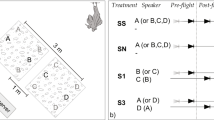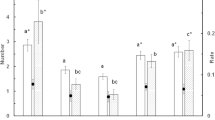Abstract
The fringe-lipped bat, Trachops cirrhosus, is an eavesdropping predator that hunts frogs and katydids by approaching these preys' sexual advertisement calls. In captivity, bats can rapidly learn to associate novel acoustic stimuli with food rewards. It is unknown how this learning ability is related to foraging behavior in the wild where prey and the calls that identify them vary over space and time. In two bat populations that differ in available prey species (Soberanía, Panama, and La Selva, Costa Rica), we presented wild-caught bats with frog calls, katydid calls, and control stimuli. Bats in Soberanía were significantly more responsive to complex calls and choruses of the túngara frog, Physalaemus pustulosus, than were bats in La Selva. La Selva bats were significantly more responsive to katydid calls (Steirodon sp.) than Soberanía bats. We also examined seasonal variation in bat response to prey cues. Bats were captured in Soberanía in dry and wet seasons and presented with the calls of a dry season breeding frog (Smilisca sila), a wet season breeding frog (P. pustulosus), and four katydid species. Bats captured in the dry season were significantly more responsive to the calls of S. sila than bats captured in the wet season, but there were no seasonal differences in response to the calls of P. pustulosus or the katydid calls. We demonstrate plasticity in the foraging behavior of this eavesdropping predator but also show that response to prey cues is not predicted solely by prey availability.



Similar content being viewed by others
References
Akre KL, Farris HE, Lea AM, Page RA, Ryan MJ (2011) Signal perception in frogs and bats and the evolution of mating signals. Science 333:751–752
Arnold SJ (1977) Polymorphism and geographic variation in the feeding behavior of the garter snake Thamnophis elegans. Science 4304:676–678
Barnard CJ, Brown CAJ (1985) Risk-sensitive foraging in common shrews (Sorex araneus L.). Behav Ecol Sociobiol 16:161–164
Bates D, Maechler M, Bolker B (2013) lme4: linear mixed-effects models using S4 classes. R package version 0.999999-2. http://CRAN.R-project.org/package=lme4. Accessed 24 May 2013
Bernal XE, Page RA, Rand AS, Ryan MJ (2007) Cues for eavesdroppers: do frog calls indicate prey density and quality? Am Nat 169:409–415
Boul KE, Ryan MJ, Lannoo MJ (2004) Population variation of complex advertisement calls in P. petersi and comparative laryngeal morphology. Copeia 3:624–631
Bruns V, Burda H, Ryan MJ (1989) Ear morphology of the frog-eating bat (Trachops cirrhosus, family: Phyllostomidae): apparent specializations for low-frequency hearing. J Morphol 199:103–119
Clare EL, Lim BK, Fenton MB, Hebert PDN (2011) Neotropical bats: estimating species diversity with DNA barcodes. PLoS ONE 6:e22648
Cramer MJ, Willig MR, Jones C (2001) Trachops cirrhosus. Mamm Species 656:1–6
Dukas R (1998) Cognitive ecology: the evolutionary ecology of information processing and decision-making. University of Chicago, Chicago
Dukas R (2004) Evolutionary biology of animal cognition. Ann Rev Ecol Evol Syst 35:347–374
Dukas R, Bernays EA (2000) Learning improves growth rate in grasshoppers. Proc Natl Acad Sci U S A 97:2637–2640
Faure PA, Barclay RMR (1992) The sensory basis of prey detection by the long-eared bat, Myotis evotis, and the consequences for prey selection. Anim Behav 44:31–39
Hedrick AV, Richert SE (1989) Genetically-based variation between two spider populations in foraging behavior. Oecologia 4:533–539
Hothorn T, Bretz F, Westfall P (2008) Simultaneous inference in general parametric models. Biom J 50:346–363
Ibáñez R, Rand AS, Jamarillo C (1999a) The amphibians of Barro Colorado Nature Monument, Soberania National Park and adjacent areas. Mizrachi and Pujol, SA, Panamá
Ibáñez R, Rand AS, Ryan MJ, Jaramillo CA (1999b) Vocalizations of frogs and toads from Barro Colorado Nature Monument, Soberanía National Park and adjacent areas [CD]. Fundación Natura, Circulo Herpetologico de Panamá and Smithsonian Tropical Research Institute, Panamá
Ings TC, Raine NE, Chittka L (2009) A population comparison of the strength and persistence of innate colour preference and learning speed in the bumblebee Bombus terrestris. Behav Ecol Sociobiol 63:1207–1218
Jones PL, Ryan MJ, Flores V, Page RA (2013) When to approach novel prey? Social learning strategies in frog-eating bats. Proc R Soc Lond B 280:2013–2330
Kelly A, Goodwin S, Grogan A, Mathews F (2008) Post-release survival of hand-reared pipistrelle bats (Pipistrellus spp). Anim Welf 17:375–382
Lang AB, Kalko EKV, Römer H, Bockholdt C, Dechmann DKN (2006) Activity levels of bats and katydids in relation to the lunar cycle. Oecologia 146:659–666
Page RA, Ryan MJ (2005) Flexibility in assessment of prey cues: frog-eating bats and frog calls. Proc R Soc Lond B 272:841–847
Page RA, Ryan MJ (2006) Social transmission of novel foraging behavior in bats: anuran calls and their referents. Curr Biol 16:1201–1205
Page RA, Ryan MJ (2008) The effect of signal complexity on localization performance in bats that localize frog calls. Anim Behav 76:761–769
Panger MA, Perry S, Rose L, Gros-Louis J, Vogel E, Mackinnon KC, Baker M (2002) Cross-site differences in foraging behavior of white-faced capuchins (Cebus capucinus). Am J Phys Anthropol 119:52–66
Peake TM (2005) Eavesdropping in communication networks. In: McGregor PK (ed) Animal communication networks. Cambridge University, Cambridge, pp 13–37
Pintor LM, Sih A (2009) Differences in growth and foraging behavior of native and introduced populations of an invasive crayfish. Biol Invasions 11:1895–1902
Raine NE, Chittka L (2008) The correlation of learning speed and natural foraging success in bumblebees. Proc R Soc Lond B 275:803–808
R Core Team (2013) R: a language and environment for statistical computing. R Foundation for Statistical Computing, Vienna, Austria. http://www.R-project.org/. Accessed 6 Nov 2013
Richards LA, Coley PD (2007) Seasonal and habitat differences affect the impact of food and predation on herbivores: a comparison between gaps and understory of a tropical forest. Oikos 116:31–40
Richards LA, Windsor DM (2007) Seasonal variation of arthropod abundance in gaps and the understory of a lowland moist forest in Panama. J Trop Ecol 23:169–176
Ryan MJ (1980) Female mate choice in a Neotropical frog. Science 209:523–525
Ryan MJ, Tuttle MD (1983) The ability of the frog-eating bat to discriminate among novel and potentially poisonous frog species using acoustic cues. Anim Behav 31:827–833
Ryan MJ, Tuttle MD, Rand AS (1982) Bat predation and sexual advertisement in a neotropical anuran. Am Nat 119:136–139
Shettleworth SJ (1998) Cognition, evolution, and behavior. Oxford University, New York
Stephens DW (1981) The logic of risk-sensitive foraging preferences. Anim Behav 29:628–629
Tandler B, Phillips CJ, Nagato T (1996) Histological convergent evolution of the accessory submandibular glands in four species of frog-eating bats. Eur J Morphol 34:63–168
ter Hofstede HM, Kalko EKV, Fullard JH (2010) Auditory-based defense against gleaning bats in neotropical katydids (Orthoptera: Tettigoniidae). J Comp Physiol A 196:349–358
Trillo PA, Athanas KA, Goldhill DH, Hoke KL, Funk WC (2013) The influence of geographic heterogeneity in predation pressure on sexual signal divergence in an Amazonian frog species complex. J Evol Biol 26:216–222
Tuttle MD, Ryan MJ (1981) Bat predation and the evolution of frog vocalizations in the Neotropics. Science 214:677–678
Tuttle MD, Ryan MJ, Belwood JJ (1985) Acoustical resource partitioning by two species of phyllostomid bats (Trachops cirrhosus and Tonatia sylvicola). Anim Behav 33:1369–1370
van Schaik C, Ancrenaz M, Borgen G, Galdikas B, Knott CD, Singleton I, Suzuki A, Utami SS, Merrill M (2003) Orangutan cultures and the evolution of material culture. Science 299:102–105
Whiten A, Goodall J, McGrew WC, Nishida T, Reynolds V, Sugiyama Y, Tutin CE, Wrangham RW, Boesch C (1999) Cultures in chimpanzees. Nature 399:682–685
Wolda H (1978) Seasonal fluctuations in rainfall, food and abundance of tropical insects. J Anim Ecol 47:369–381
Zuk M, Kolluru GR (1998) Exploitation of sexual signals by predators and parasitoids. Q Rev Biol 73:415–438
Acknowledgments
We thank the staff of the Smithsonian Tropical Research Institute and the Organization for Tropical Studies for aid and support with research and permits in Soberanía and in La Selva. Thank you to Hannah ter Hofstede for providing the katydid calls, and Ximena E. Bernal, Roberto Ibáñez, A. Stanley Rand, and Michael Reichert for recording the frog calls. Thanks also to Sara Troxell, Sean Griffin, Martha Moscoso, Christina Buelow, Sarah Richman, Jay Falk, Teia Schweizer, and Victoria Flores for help capturing and caring for bats. We thank the Gamboa Bat Lab, Christian Voigt, Brock Fenton, and one anonymous reviewer for insightful comments on the manuscript. This study was funded by a National Science Foundation Graduate Research Fellowship (PLJ) as well as grants from the University of Texas at Austin (PLJ) and the Smithsonian Tropical Research Institute (PLJ).
Ethical standards
The authors declare that the experiments conducted in this research comply with the current laws in Costa Rica, Panamá, and the USA. Research in Soberanía National Park was approved by the Panamanian authorities (Autoridad Nacional del Ambiente (ANAM) permit # SE/A-91-09, SE/A-95-10, SE/A-6-11, SE/A-46-11, and SE/A-94-11) and in La Selva was approved by the Costa Rican authorities (Sistema Nacional de Áreas de Conservación permit # 027-2010-SINAC). Animal care was conducted according to the approved Institute for Animal Care and Use Committee protocols from the University of Texas (protocol AUP-2009-00138) and the Smithsonian Institution (protocol 20100816-1012-16).
Conflict of interest
The authors declare that they have no conflict of interest.
Author information
Authors and Affiliations
Corresponding author
Additional information
Communicated by C. Voigt
Rights and permissions
About this article
Cite this article
Jones, P.L., Ryan, M.J. & Page, R.A. Population and seasonal variation in response to prey calls by an eavesdropping bat. Behav Ecol Sociobiol 68, 605–615 (2014). https://doi.org/10.1007/s00265-013-1675-6
Received:
Revised:
Accepted:
Published:
Issue Date:
DOI: https://doi.org/10.1007/s00265-013-1675-6




